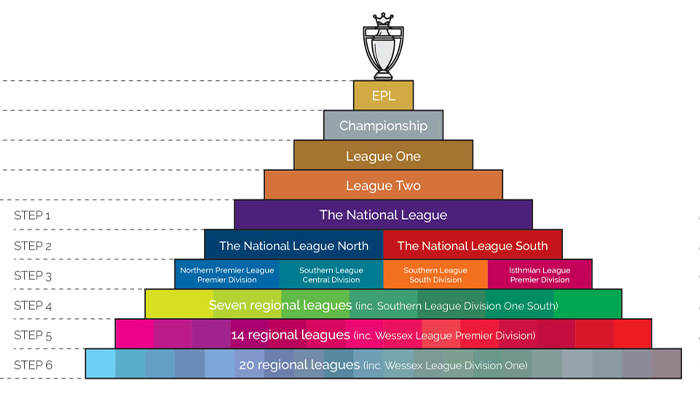Explaining the English Soccer Pyramid System
 English Soccer Pyramid System
English Soccer Pyramid System
The English Soccer Pyramid System is a hierarchical structure that organizes football clubs into various leagues based on their performance and standings. This intricate system allows for promotion and relegation between different levels, providing opportunities for teams to climb or descend the football hierarchy. The structure is a fundamental aspect of English football, fostering competition, ambition, and a sense of achievement for clubs across the country.
At the pinnacle of the English football league system are the top four professional divisions, collectively known as the English Soccer League Tiers. These tiers are the Premier League, EFL Championship, EFL League One, and EFL League Two. The term “tiers” refers to the different levels of competition within the overall structure, with each tier representing a distinct level of skill, competition, and prestige.
The foundation of the English Soccer Pyramid System extends beyond the professional leagues, encompassing a myriad of regional and local leagues at various levels. The entire structure is interconnected, allowing clubs to move up or down the pyramid based on their performance in the respective leagues. This mechanism, known as promotion and relegation, adds a dynamic and competitive element to the English football landscape.
The English football league system is often referred to as the English Football League System, highlighting the organized and comprehensive nature of the structure. From grassroots football to the illustrious Premier League, the system accommodates a diverse range of clubs, each with its own history, fan base, and aspirations. The English Football League System embodies the inclusive spirit of the sport, providing a platform for both established clubs and rising talents to showcase their abilities.
At the summit of the pyramid is the Premier League, widely regarded as one of the most prestigious and competitive football leagues globally. The top tier is home to renowned clubs with storied histories, and its matches are watched by millions of fans worldwide. The allure of the Premier League lies not only in the high level of football but also in the financial rewards and global exposure it offers to participating clubs.
Beneath the Premier League is the EFL Championship, the second tier of the English Soccer League Tiers. The Championship is fiercely competitive, with clubs vying for promotion to the Premier League, where the stakes are higher in terms of revenue, prestige, and exposure. Simultaneously, teams in the Championship must be wary of relegation to the third tier, EFL League One, which adds an element of pressure and intensity to the competition.
Further down the pyramid, EFL League One and EFL League Two constitute the third and fourth tiers, respectively. Clubs in these divisions compete for promotion to higher tiers or strive to maintain their position and avoid relegation. The competitive nature of these leagues is palpable, as success can propel a club into the spotlight, while struggles may result in a drop to a lower level.
Beyond the professional tiers, the English Soccer Pyramid System encompasses numerous regional leagues, county leagues, and grassroots competitions. This extensive network ensures that football is accessible and inclusive at all levels, allowing local clubs to participate in competitive leagues and providing a pathway for talent development.
The English Soccer Pyramid System is a comprehensive and interconnected structure that organizes football clubs into various tiers, each representing a different level of competition. The system, often referred to as the English Football League System, fosters competition, inclusivity, and ambition within the football landscape. From the pinnacle of the Premier League to the grassroots leagues, the pyramid accommodates a diverse range of clubs, creating a dynamic and competitive environment that is integral to the essence of English football.
Sports Betting on English Football
Betting on English League Football matches has become an integral part of the sports-watching experience for many fans, adding an extra layer of excitement and engagement to the beautiful game. While it can be an entertaining pastime, it’s crucial for individuals to approach sports betting responsibly and be aware of the potential risks involved.
One of the most common types of bets in English League Football is the match outcome within the English Soccer League Tiers, where bettors predict whether a particular team will win, lose, or the match will end in a draw. The odds for each outcome are determined by various factors, including team form, player injuries, and historical head-to-head statistics. This straightforward bet is popular among both seasoned bettors and casual fans looking to enhance their viewing experience.
In addition to match outcomes, various other betting options are available, such as over/under goals, first goalscorer, and both teams to score. These bets provide a diverse range of options for bettors to explore, allowing them to focus on specific aspects of the game beyond just the final result. This diversity contributes to the appeal of football betting, offering a wide array of choices for enthusiasts with varying levels of expertise.
Soccer/football fans can also bet live on league two soccer, whether game props, player props, or match outcomes.
While betting on English League Football matches can add excitement, it’s important to approach it with caution and responsibility. Understanding the odds, staying informed about team news, and avoiding impulsive decisions are essential elements of responsible sports betting. Setting a budget and adhering to it helps prevent excessive spending, ensuring that the enjoyment derived from betting remains within reasonable limits.
The influence of betting on English League Football extends beyond individual experiences, as the industry contributes significantly to the commercial aspect of the sport. Sponsorship deals with betting companies, prominently displayed on team jerseys and in stadiums, showcase the symbiotic relationship between football and the betting industry. This relationship has faced scrutiny, leading to discussions about responsible gambling and the potential impact on vulnerable individuals.
The rise of online betting platforms has made it more convenient for fans to place bets on English League Football matches. Mobile apps and websites offer a user-friendly interface, live in-play betting options, and real-time statistics, providing bettors with a comprehensive experience. This includes league one soccer betting sites. However, the accessibility and convenience of online betting also raise concerns about its potential impact on problem gambling and addiction, necessitating regulatory measures and responsible gambling initiatives.
Wagering on English League Football matches has become an integral part of the fan experience, contributing to the excitement and engagement with the sport and the English Soccer Pyramid System. While it can enhance the enjoyment of watching matches, responsible gambling practices are crucial to ensuring that individuals do not succumb to the potential risks associated with betting. As the industry continues to evolve, a balance between entertainment and responsible behavior is essential to maintain the integrity and enjoyment of both football and sports betting.
English Football Leagues in Order
- Premier League: 20 teams
- English Football League Championship: 24 teams
- English Football League One: 24 teams
- English Football League Two: 24 teams
- National League: 24 teams
Those top five tiers are followed by three lower levels often referred to as non-league football. Though the bottom English Football leagues are indeed leagues, and are for the most part professional clubs. Teams from the bottom tiers can be promoted up the pyramid, though it is more difficult. There are thousands of football clubs in the English football league system, but it’s the top levels, the Premier League and the others at the top of the pyramid that attract the most fan memberships and attention.




